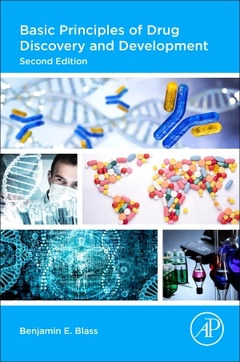Description
Basic Principles of Drug Discovery and Development (2nd Ed.)
Author: Blass Benjamin E.
Language: English
Subject for Basic Principles of Drug Discovery and Development:
Approximative price 145.45 €
In Print (Delivery period: 14 days).
Add to cart750 p. · 15.2x22.8 cm · Paperback
Description
/li>Contents
/li>Readership
/li>Biography
/li>Comment
/li>
- Provides a clear explanation of how the pharmaceutical industry works, as well as the complete drug discovery process, from obtaining a lead, to testing the bioactivity, to producing the drug, and protecting the intellectual property
- Includes a new chapter on the discovery and development of biologics (antibodies proteins, antibody/receptor complexes, antibody drug conjugates), a growing and important area of the pharmaceutical industry landscape
- Features a new section on formulations, including a discussion of IV formulations suitable for human clinical trials, as well as the application of nanotechnology and the use of transdermal patch technology for drug delivery
- Updated chapter with new case studies includes additional modern examples of drug discovery through high through-put screening, fragment based drug design, and computational chemistry, as well as studies on the development of biologics
1. Drug Discovery and Development: An Overview of Modern Methods and Principles 2. The Drug Discovery Process: From Ancient Times to the Classical Targets in Drug Discovery 3. In Vitro Screening Systems 4. Medicinal Chemistry 5. In vitro ADME and In vivo Pharmacokinetics 6. Animal Models of Disease States 7. Safety and Toxicology 8. Basics of Clinical Trials 9. Translational Medicine and Biomarkers 10. Organizational Considerations and Trends in the Intellectual Property and Patents in Drug Discovery 11. Case Studies in Drug Discovery
Upper level undergraduate students, graduate students interested in drug discovery research, chemistry, biology, pharmacology, biochemistry, toxicology, formulations, discovery/development of new therapeutic agents; pharmaceutical industry; FDA, public policy groups interested in influencing the pharmaceuticals industry; business analysts, entrepreneurs, venture capitalist interested in investing in the pharmaceuticals industry
- Provides a clear explanation of how the pharmaceutical industry works, as well as the complete drug discovery and development process, from obtaining a lead, to testing the bioactivity, to producing the drug, and protecting the intellectual property
- Includes a new chapter on the discovery and development of biologics (antibodies proteins, antibody/receptor complexes, antibody drug conjugates), a growing and important area of the pharmaceutical industry landscape
- Features a new section on formulations, including a discussion of IV formulations suitable for human clinical trials, as well as the application of nanotechnology and the use of transdermal patch technology for drug delivery
- Updated chapter with new case studies includes additional modern examples of drug discovery through high through-put screening, fragment-based drug design, and computational chemistry




